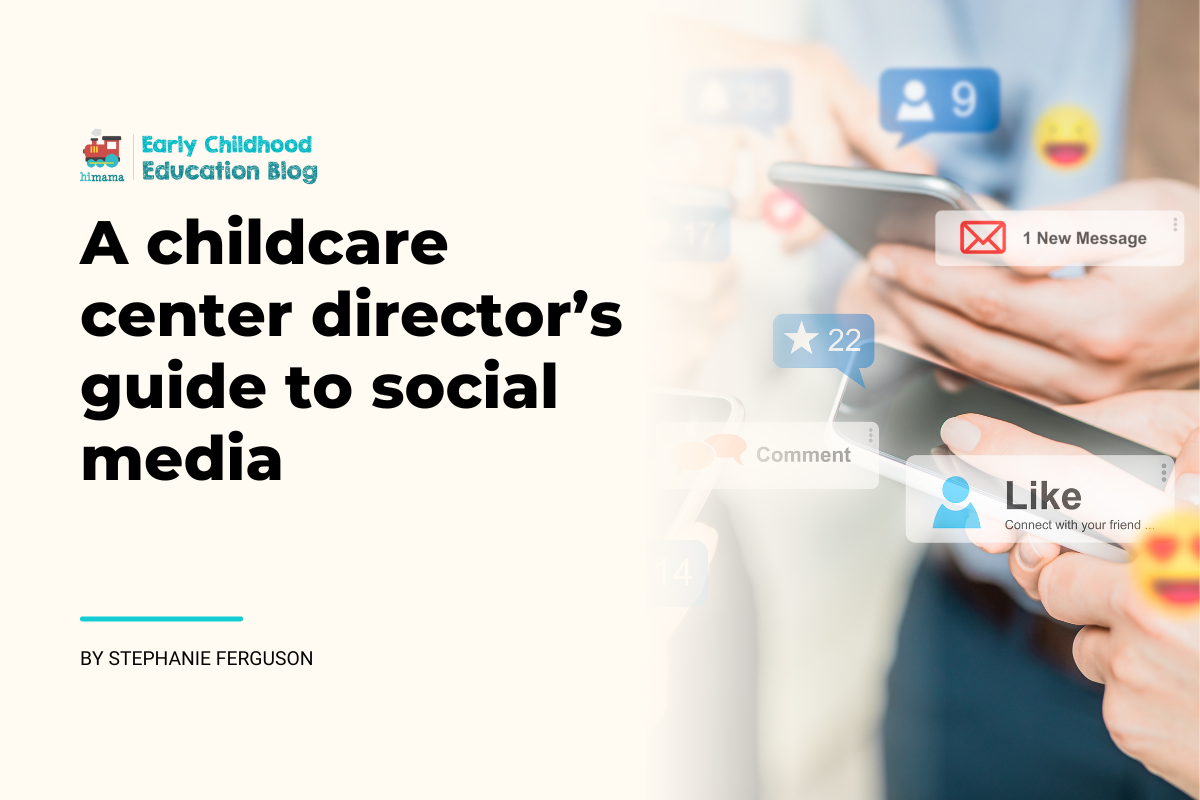While social media has always been a great way for childcare centers to interact with parents, the COVID-19 pandemic illustrated just how important this tool can be to help everyone stay connected. According to Statista, since the onset of the pandemic, consumers have admitted to being “ultra-connected” with their communities, with over 40% spending more time on messaging services and social media than before.
Social media is an invaluable tool that can help you:
1) Strengthen your relationship with current families to:
- Encourage retention and re-enrollment
- Nurture positive testimonials and new family referrals
2) Reach an audience of new families by:
- Building brand awareness
- Generating leads
- Engaging with prospects
Social media has become a widely accepted source of valuable information for parents, with Facebook and Instagram being among the most widely used platforms. A study conducted by Pew Research Center revealed that in particular, “mothers are heavily engaged on social media, both giving and receiving a high level of support via their networks.”
Parents use Facebook as a way to connect with family and friends by posting comments, sharing photographs and short videos, and posting links to interesting content. Like many other consumers, parents are now also using Facebook to find and explore local businesses.
Business Pages
You may already have a personal Facebook page, but to effectively market your childcare center on Facebook, you need to create a Facebook Business Page.
When you are creating your Business Page, be sure to include:
- A compelling brand image for your profile photo.
- A succinct description (profile) of your center.
- All relevant contact information (website, address, phone number).
- A search-friendly username (@Username), usually your center’s brand name. This is how parents can find your center on Facebook.
- Photos that showcase the daily routines at your center.

The Facebook Algorithm
To attract and maintain followers (who will one day hopefully become new parents at your center!), you need to post content regularly and ensure your content is worth following; i.e. content that provides value.
Creating great content is also important in helping secure your post’s position on Facebook due to the Facebook algorithm. The Facebook algorithm controls the ordering and presentation of posts and ads in users’ news feed so that users see what is most relevant to them at the top of their news feed, instead of just receiving content chronologically.
The number one priority for Facebook (and Instagram) is to keep users engaged. As a result, their algorithms are focused on serving content with the highest engagement and relevance. To do this, the algorithms rank all available posts based on how likely it is that the user will have a positive reaction to them, then serves the user those posts that receive the highest rankings.
Here are a few tips on how the Facebook algorithm works:
- Your past interactions with your audience are taken into consideration. If your audience has clicked on your links or liked or commented on your posts, your content will rank higher on their news feed.
- Posts with content that generates more engagement, such as photos and videos will rank higher on your audience’s news feed, followed by links and text updates.
- Posts that are recent and therefore more relevant will rank higher on your audience’s news feed.
Types of Facebook Content
There are five main types of Facebook content:
1) Video
Video is the most engaging type of social media content. You can easily create a short, high-quality video of a special event or learning activity at your center or a quick tour of one of your classrooms.
2) Images
Images (photos, infographics, illustrations) are also highly engaging and a great way to build brand awareness. Share photos of children’s work or showcase your healthy lunch offerings.
3) Stories
Stories are photos or short videos that appear at the top of the news feed that disappear after 24 hours. Stories help your audience get to know your business better in a more casual and personable way.
4) Link Posts
Link posts are posts that contain links to content outside of Facebook. You can easily create a link post by copying and pasting a link into the status box. Facebook then ‘fills in’ the photo and meta description (a brief summary of a web page). Link to content from your center’s website, such as your latest blog, or websites from industry thought leaders.
5) Text Posts
Text is the most basic type of post, as it doesn’t include videos, photos, or links. Posting a question is one way to spark feedback and engagement with users. For example, “What Thanksgiving craft do you remember making as a child?” (For me, it’s the hand-print turkey!)
Ways to Connect On Facebook
In addition to posting content and comments on your Business Page, you can also connect with your Facebook audience by following them, liking their posts, tagging them in your post (this identifies them in your post and then notifies them), or via Messenger, Public Groups, and Private Groups:

Messenger
Messenger is an instant messaging feature that allows Facebook users to connect with each other and send instant messages, emojis, photos, and videos. Messaging can help you build a one-on-one relationship with prospective families and establish trust and credibility. It is also an opportunity for you to quickly answer any questions they may have or book them in for a tour!
Public Groups
With Public Groups, anyone can see the group’s name, location, member list, and posts, and the group can show up in anyone’s searches or news feed. Anyone can add themselves as a member of a public group without any invite or approval. Creating a Public Group is a great way to develop a community around your center and build loyalty and advocacy.
Private Groups
With Private Groups, only members can see who’s in the group and what they post. Private groups still show up in searches, but potential members need to be accepted by the group administrators. A private group is like belonging to an exclusive club.
An advantage to creating and using Facebook Groups is that the Facebook algorithm gives group postings more priority, which means they tend to consistently appear at the top of the news feed.
Instagram is another social network that parents use to share what’s happening in the moment with friends and family by posting photos and short videos. It can be described as a simplified version of Facebook, with an emphasis on mobile and visual sharing. The use of Instagram expanded beyond just a social tool to a new way of discovering products and businesses. In fact, Instagram reports that 90% of their accounts follow a business.
Instagram is a downloadable app that is available for iOS and Android. You can easily set up an Instagram Business Profile using your business email address. When you create your Business Profile be sure to include:
- A compelling brand image for your profile photo (or your center’s logo).
- A succinct bio (profile) of your center.
- All relevant contact information (website, address, phone number)
- A search-friendly username (@Username). You should use the same username for Instagram as you use for your Facebook Business Page.
The Instagram Algorithm
Similar to Facebook, Instagram uses an algorithm to control the ordering and presentation of posts that users see when they’re scrolling through their Instagram feed. Just like the Facebook algorithm, the Instagram Algorithm prioritizes posts, pushing the most relevant ones towards the top and giving them the most visibility, while other content is placed further down in one’s feed.

Here are a few tips on how the Instagram algorithm works:
- Content that is relevant to your audience’s interests (genres of content that they’ve interacted with in the past) will rank higher on their feed.
- Accounts that your audience regularly interacts with (their relationship with the person/business) will rank higher on their feed.
- Posts that are recent and therefore more relevant will rank higher on your audience’s feed.
Types of Instagram Content
Instagram provides a different user experience than Facebook because it is strictly focused on visual-based content; video, images, and stories. The main difference between the visual content posted on Facebook vs. Instagram is that Instagram has many easy-to-use editing and design apps available to help you enhance the quality of your photos and videos to increase engagement.
Ways to Connect On Instagram
In addition to posting content on Instagram, you can also interact with your audience by following them, liking their posts, tagging them in your posts, or via Instagram Direct (similar to Facebook Messenger), and using hashtags:
A Hashtag is a combination of letters, numbers, and/or emojis preceded by the # symbol (e.g. #EarlyLearning). They are used to categorize content and make it more discoverable. If you click on an Instagram hashtag or do an Instagram hashtag search, you will be shown a page with all of the posts tagged with that hashtag. Hashtags are a great way to build an online community and increase engagement with your audience. You can create a hashtag for your childcare center, services provided, special event, or craft activity.
Ready to get social? Follow @hiamama on Instagram and Facebook for inspiration!



Hello, what an informative article! I’m wondering if you have any specific tips on how to use an Instagram account to promote a preschool? Examples of content or where I can find them? Thank you so much!